Here are images of the draft script of my performance. At the moment, this is where I am up to. I know there are gaps to fill but there will be time for editing once I am finished with the whole draft.
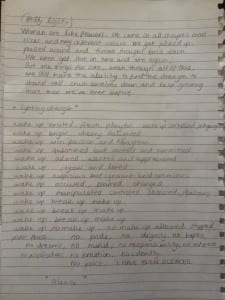
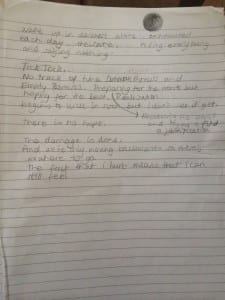
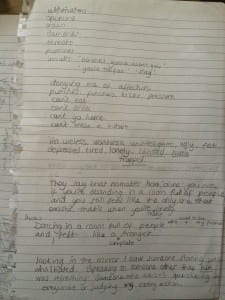
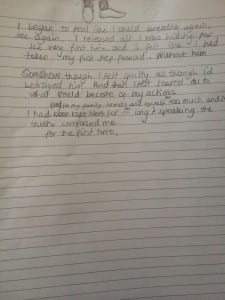
Solo Performance
Here are images of the draft script of my performance. At the moment, this is where I am up to. I know there are gaps to fill but there will be time for editing once I am finished with the whole draft.




One thing I swore that my piece was not going to be, was autobiographical. However, seeing as though it was connection to my previous ideas that I had been lacking, I thought it to be possibly the best thing for me to explore. I also wanted my solo performance to show who I am as well as my performative abilities. The desire to work with flowers was still present and I kept this in mind whilst beginning to write automatically. A page and a half later, I gave it a read through and before I could edit it, I video recorded my lips speaking it. In this monologue I speak of domestic abuse. This is a subject that I am very much connected to.
The flowers that I wish to utilize in my piece represent the breakdown of a person related to domestic abuse, particularly relationship abuse. I have an image of sitting in a darkened room with a single spotlight above me, a photo frame hung in front of me, a flower in my hands and tape across my mouth. Audio will play whilst the video projection of my lips will speak over the top of my taped mouth. The tape represents the inability to speak whilst the frame does a similar thing in that pictures are immobile and speechless, so it is as though I am the still picture. Nevertheless, I will begin to pick the petals from the flower signifying that my mentality as well as my physicality are both weakening until I am left with only the stem of the flower, only the skeleton of a person. The piece will continue where I will attempt to mend the flower, piecing it back together with the tape from my mouth. This symbolises the rebuild of a person and how hard it is to try and fix something so fragile. I also feel that the aesthetics here will be both ugly and beautiful simultaneously. The way in which the black tape covers the coloured petals shows the scars that cover a person, whether they are seen on the body or lived with internally, they may fade but will never disappear. Considering that all of the tape from my mouth will be wrapped around the flower, the end of the piece will finish by showing the ability to speak again, and like a flower, representing my growth in strength, happiness and beauty.
Throughout the duration of the sessions thus far, I have been interested in many ideas as a stimulus for my performance. I knew that I wanted to involve the audience by either allowing them to relate to my performance or for them to actually participate. After researching Tim Crouch, I recognised that he too, liked to include his audience within his performances. Although this idea of mine didn’t directly relate to Crouch’s work, it does however, resemble his artistic intentions.
There was a range of ideas that I had thought of exploring, from the theme of temptation to wanting to physically create a world of mystery and imagination. These ideas seemed too far-fetched and I had a lot of difficulty executing them to a professional standard. I was also unsure of the meaning behind my ideas and was ultimately not connecting to any of them. This meant that a change of direction was needed.
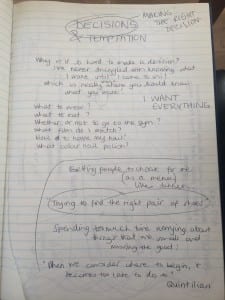
I recently came across an image that made me rethink my intentions. The image stated ‘THE EARTH WITHOUT ART IS JUST ‘EH”. This inspired thought about a world which exists without all artistic influences. A world which I could explore in a performance format. I was imagining life without music, sculptures, paintings, film, theatre, books and fashion etc. These forms of art don’t seem to fit under just one category, meaning that my performance would not be focusing on specifics and instead giving a general overview. I decided that if this was the direction I was to take, I would need to condense what I classify as “art” for the purposes of this project. In my opinion, flowers coincide with this notion of earth and art and I would really enjoy experimenting with them in order to explore this concept.

After discussing this idea with the rest of the group, I opted to take things in a different direction because my idea seemed too broad to explore. I understood that if I wanted to make further progress I would need to condense my content, but because I had generated so many ideas around this topic, it was too difficult to choose a specific path to follow.
After looking over my mind maps to influence my decision, I had noticed my passion for wanting to experiment with flowers. I decided that this was to be my stimulus.
In Matt Chewiwie’s artistic statement he explains that an artist once said that ‘life is a big nasty vicious dragon’ but then admits that he doesn’t know who made that particular statement (Chewiwie, 2008). Chewiwie also declares, ‘I see myself more of an entertainer’ than an artist and speaks about not taking himself too seriously (Chewiwie, 2008). His work for example, consists of videoing himself switching on a lightbulb and falling off a ladder, attempting to run on water and inventing animated YouTube videos mimicking his friends, previous famous computer games or celebrities.
Chewiwie’s intentions are to make people feel, (laugh or cry etc.) and once this is achieved he feels as though his job is done. In comparison to Marina Abramovic’s work, she intends to ‘transform herself’ as opposed to transforming the audience (O’Hagan, 2010). However, the renovation of the audience occurs when they cry or feel angry etc. It is this transformation that is not intended but comes naturally to the audience. Abramovic claims that ‘you’re an artist if you wake up in the morning and you are obsessed to create and you have the urge to create’ (Louisiana Channel, 2013). Of course this is just Abramovic’s opinion on the definition of an artist. Her work shows that she is clearly obsessed and desperate to create considering the amount of pressure and self inflicted pain that she puts upon herself, in order to push boundaries.
In the Oxford Dictionary, an artist is one who is ‘skilled at a particular task or occupation’ (2014). This definition suggests that an artist is someone who is talented or creative at what they do and are not specifically artists just because they have the ability to do it. Regarding both Chewiwie and Abramovic, they do not show any particular skill within their work. Okay, Chewiwie can evidently use a camera and a computer and Abramovic can sure enough push her mind and body to extreme lengths and endure pain over a period of hours, days, weeks and months. It can be said that the pair are both artists as they have each created or invented something in particular, but is this enough? Are they indeed, skilled?
In my opinion, Abramovic is an artist not because of her work but because of her beliefs in her work. She is self-assured of her intentions and of course herself. It is this “taking the self seriously” that I believe matters. Like Chewiwie, if one does not take himself seriously enough, then the odds are no-one else will either. For one who states that he is ‘dictated by [his] inner child’ evidently shows Chewiwie has a more jovial approach to creating art (Chewiwie, 2008).
In addition, I don’t believe that it takes someone else to label another as an artist in order for them to become one. For me, Abramovic is and Chewiwie is not an artist, but that doesn’t mean that my opinion stands correct. For me, there is no right and wrong and I believe that art is in the eye of the beholder as the perception of art is subjective.
Chewiwie, Matt (2008) Matt Chewiwie’s Artistic Statement [online][YouTube] <Accessed 28th February 2014> Available at: https://www.youtube.com/watch?v=4yJPZfFOrsc
Louisiana Channel (2013) Marina Abramovic – Advice to the Young [Online][YouTube] <Accessed 28th February 2014> Available at: https://www.youtube.com/watch?v=8Ck2q3YgRlY
O’Hagan, Sean (2010) ‘Interview: Marina Abramovic’, The Guardian [Online] <Accessed 28th February 2014> Available at: http://www.theguardian.com/artanddesign/2010/oct/03/interview-marina-abramovic-performance-artist
The Oxford Dictionary (2014) Artist [Online] <Accessed 28th February 2014> Available at: http://www.oxforddictionaries.com/definition/english/artist?q=artist
American solo performer Amy Taubin focuses on the ‘representation of the self’ (Noel, 1979, p. 57) where she aspires to explore her own identity as a woman, a body and a performer. Her performances aim to assure that the audience’s relationship to the soloist is undivided. She creates three performances that present the notion of being seen as an object. Pimping for herself, Double Occupancy and Performance Which Began On A Train examine the relationship between audience and performer as she wishes to characterise the feelings of division.
In Pimping for herself, Taubin uses film to make literal the idea of the performer being used as an object ‘whose primary function is to be seen, to be observed’ (Noel, 1979, p. 56). Taubin acknowledges the audience when she is present on stage causing them to feel objectified as a result. There is a film which is shown during the piece which exposes Taubin undressing. Later on she enters the performance space and repeats the act of undressing whilst glaring at each audience member. This is ironic because although Taubin should feel as though she is receiving full attention, the audience feel objectified also. On some level, I wondered how she can fully equalise the performer/spectator relationship when at any one point Taubin is ensuring that either of them is experienced as an object. However, it is seemed that by the end of the piece both parts are equal as both have experienced being the centre of attention.
Double Occupancy again uses media but this time, audio. In this particular performance Taubin wants to create two responses within her audience between what is seen and what is heard. She wishes to discover how these methods of interaction can reflect messages in different ways. By sitting in a separate room and being watched through a window presents the concept of being looked at as a solid element of being a woman in a man’s society and how the woman then ‘learns to be an attractive object of man’s desire’ (Noel, 1979, p. 56). A thought that had occurred to me was the difference in the piece if it were to be performed by a male. As a female, Taubin represents women in a male-led society. Therefore if the piece was indeed performed by a man, the fabric of the piece would be lost as the main intentions centre themselves around the objectivity of women.
This method of being heard as opposed to being seen also creates a relationship between men and women as well as spectator and performer. I feel that by being watched an automatic relationship is established and formed between audience and performer, however by solely listening to another, something more intimate and personal is created.
For the purposes of Performance Which Began On A Train, it is the audience who are fully lit yet Taubin stands in darkness. By reading from a script that is heard through speakers within the room and appearing on a projection on one of the walls, Taubin has established a dichotomy of the ‘invisible living, inner voice with its visible outer manifestation’ (Noel, 1979, p. 56). By also recording the audience live through film they are encouraged to see themselves on a screen in order to experience objectification.
Carrol, Noel (1979) ‘Amy Taubin: The Solo Self’, The Drama Review, Vol. 23 (1) pp 51-58.